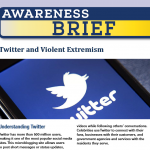
Online radicalization to violence is the process by which an individual is introduced to an ideological message and belief system that encourages movement from mainstream beliefs toward extreme views, primarily through the use of online media, including social networks such as Facebook, Twitter, and YouTube. A result of radical interpretations of mainstream religious or political doctrines, these extreme views tend to justify, promote, incite, or support violence to achieve any number of social, religious, or political changes.
